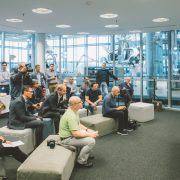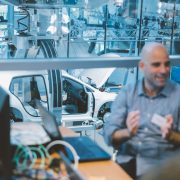E-Mobility Plugfest: The Heating Communicates With the Car

The first e-mobility Plugfest of the EEBUS initiative in June is now followed by the second one. Put to the test: All generators and loads in the home are interconnected to communicate via energy management platforms, such as ennexOS from SMA. PV systems, heating, home appliances and even charging stations for electric cars will thus have to be optimally connected with each other for optimized use of energy in all areas of application.
Today, a modern residential building can produce significantly more energy than it needs with a PV system. It’s already extremely economical to charge the growing number of electric cars using this excess electricity. This is one of the reasons why over 80% of electric cars are charged at private charging stations.1
In the domestic network, communication is organized by a control center, such as the ennexOS energy management platform.
“With the EEBUS specifications, we integrate all energy generators, loads and storage systems across the electricity, heating and e-mobility sectors into the system and use a fully automated approach to ensure that energy is being used efficiently, without sacrificing convenience. This means that households and companies can make significant savings on electricity costs.”
Frank Blessing
Networking with EEBUS prevents conflicts in electricity supply
The electricity demand of electric cars may compete with other loads in the house. The EEBUS initiative is developing a common, standardized language that makes communication across all energy sectors possible.
“At Plugfest, we saw that the result of last months’ work on paper was that different devices can actually communicate with each other.
Together, e-mobility and renewables can thus make a big step forward.”
Matthias Groene
In practice, the EEBUS specifications define three core e-mobility areas via which energy managers and charging equipment communicate:
- Increasing efficiency: As much self-generated electricity as possible will be used for charging electric cars.
- Relieving the utility grid: The charging process will be agreed with the grid operator.
- Overload safety: The electric car and its charging technology always take the entire house into account. If a boiler switches on, for example, the charging current will be reduced to prevent an overload.
“It was inspiring to see active cooperation across industries and amongst competitors on a unified communication protocol toward the development of the future grid. What is being accomplished with the EEBUS Initiative and demonstrated at the PlugFest events is a strong example for international markets on what is achievable through cooperative effort and standardization on automated EMS control logic.”
Kevin Myers
Networking through EEBUS will enable a quick expansion of charging technology infrastructure. In many cases, the power required by charging stations already exceeds the available capacity of the utility grid. Intelligent energy management avoids intervention in the utility grid and can save on expensive construction works.
“Developing the framework of tomorrows Energy Management and eMobility takes a unified approach, and this is exactly what I witnessed at the EEBUS PlugFest. Players from various segments coming together to engineer this common infrastructure to the benefit of everyone, not least of which the consumer!”
Bo Lonborg Mueller
Impressions of the second plugfest e-mobility
Read more
The press release on the second e-mobility Plugfest can be found here.
1Investigation by the German National Platform for Electric Mobility, as of September 2017.











Feel free to contribute!